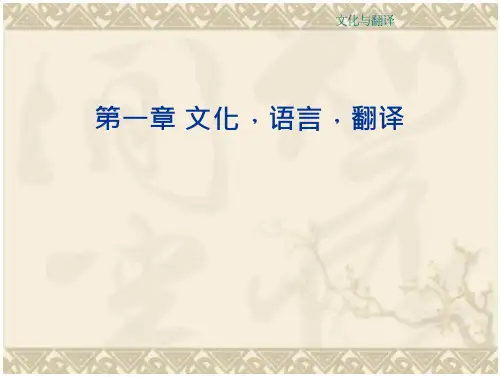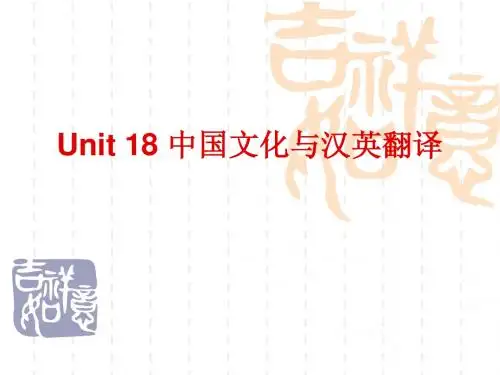中国文化与翻译2全解共73页
- 格式:ppt
- 大小:9.36 MB
- 文档页数:73
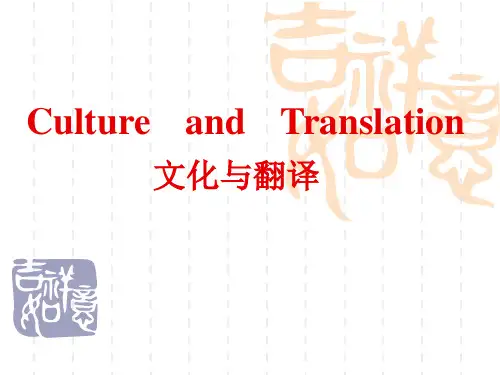

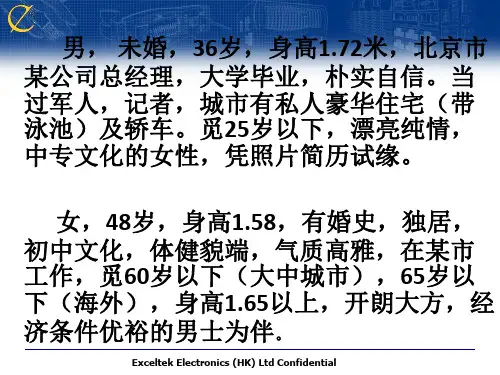
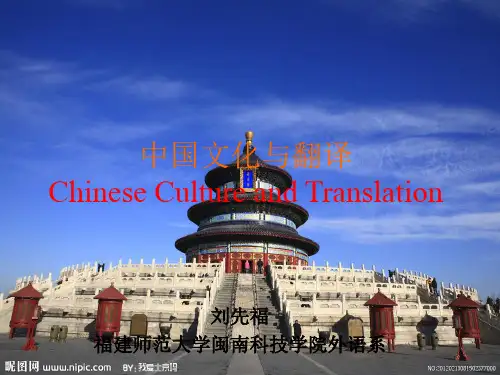
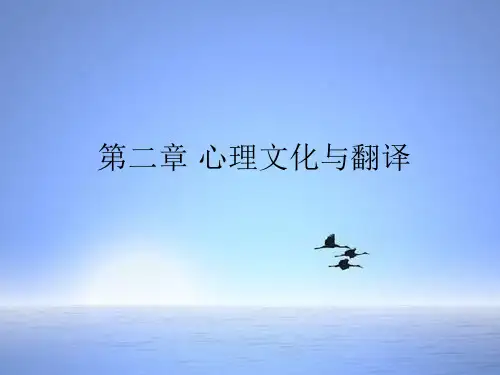

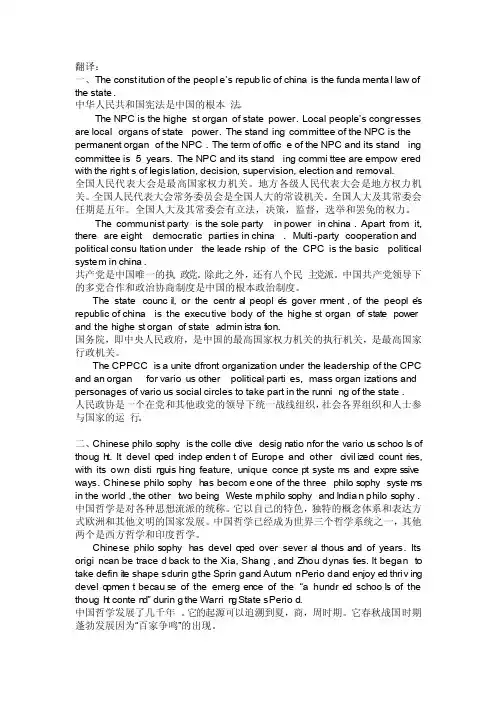
翻译:一、The consti tutio n of the people’srepubl ic of chinais the fundam ental law of the state.中华人民共和国宪法是中国的根本法。
The NPC is the highes t organof statepower. Localpeople’scongre ssesare localorgans of statepower.The standi ng commit tee of the NPC is the perman ent organof the NPC. The term of office of the NPC and its standi ng commit tee is 5 years.The NPC and its standi ng commit tee are empowe red with the rights of legisl ation, decisi on, superv ision, electi on and remova l.全国人民代表大会是最高国家权力机关。
地方各级人民代表大会是地方权力机关。
全国人民代表大会常务委员会是全国人大的常设机关。
全国人大及其常委会任期是五年。
全国人大及其常委会有立法,决策,监督,选举和罢免的权力。
The commun ist partyis the sole partyin powerin china.Apartfrom it, thereare eightdemocr aticpartie s in china.Multi-partycooper ation and politi cal consul tatio n underthe leader shipof the CPC is the basicpoliti cal system in china.共产党是中国唯一的执政党。
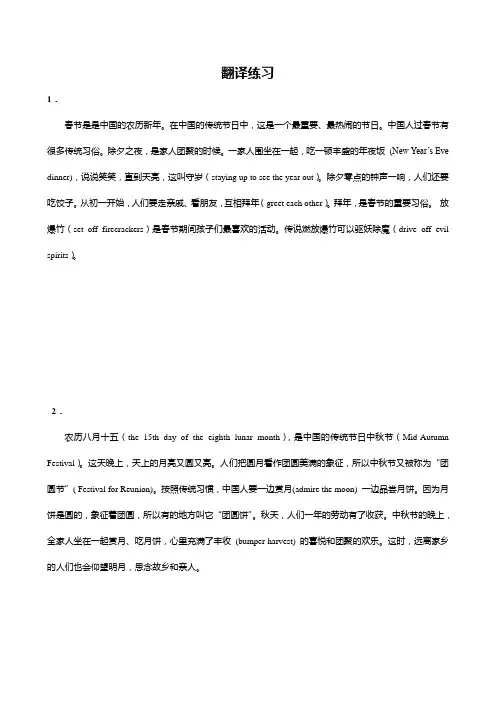
翻译练习1.春节是是中国的农历新年。
在中国的传统节日中,这是一个最重要、最热闹的节日。
中国人过春节有很多传统习俗。
除夕之夜,是家人团聚的时候。
一家人围坐在一起,吃一顿丰盛的年夜饭(New Year’s Eve dinner),说说笑笑,直到天亮,这叫守岁(staying up to see the year out)。
除夕零点的钟声一响,人们还要吃饺子。
从初一开始,人们要走亲戚、看朋友,互相拜年(greet each other)。
拜年,是春节的重要习俗。
放爆竹(set off firecrackers)是春节期间孩子们最喜欢的活动。
传说燃放爆竹可以驱妖除魔(drive off evil spirits)。
2.农历八月十五(the 15th day of the eighth lunar month),是中国的传统节日中秋节(Mid-Autumn Festival)。
这天晚上,天上的月亮又圆又亮。
人们把圆月看作团圆美满的象征,所以中秋节又被称为“团圆节”( Festival for Reunion)。
按照传统习惯,中国人要一边赏月(admire the moon) 一边品尝月饼。
因为月饼是圆的,象征着团圆,所以有的地方叫它“团圆饼”。
秋天,人们一年的劳动有了收获。
中秋节的晚上,全家人坐在一起赏月、吃月饼,心里充满了丰收(bumper harvest) 的喜悦和团聚的欢乐。
这时,远离家乡的人们也会仰望明月,思念故乡和亲人。
3.英语中的“china”一词有两个意义,一个是中国,一个是瓷(porcelain)。
西方人很早就把中国与瓷器联系在一起,这是因为瓷器是中国人发明的。
瓷器是从陶器(pottery) 发展来的,如果从生产原始瓷器的商代(Shang Dynasty)算起,中国的瓷器大约有三千多年的历史了。
江西景德镇被称为中国的“瓷都”(the Capital of Porcelain)。
中国瓷器不仅是精美的日用品,也是珍贵的艺术品。
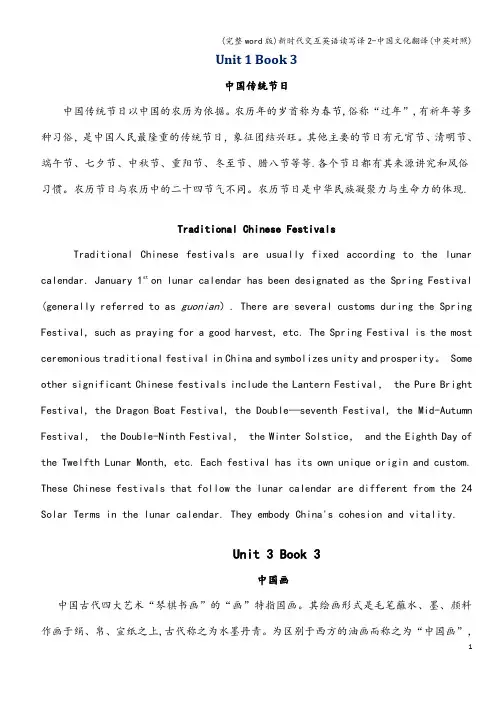
Unit 1 Book 3中国传统节日中国传统节日以中国的农历为依据。
农历年的岁首称为春节,俗称“过年”,有祈年等多种习俗,是中国人民最隆重的传统节日,象征团结兴旺。
其他主要的节日有元宵节、清明节、端午节、七夕节、中秋节、重阳节、冬至节、腊八节等等.各个节日都有其来源讲究和风俗习惯。
农历节日与农历中的二十四节气不同。
农历节日是中华民族凝聚力与生命力的体现.Traditional Chinese FestivalsTraditional Chinese festivals are usually fixed according to the lunar calendar. January 1st on lunar calendar has been designated as the Spring Festival (generally referred to as guonian). There are several customs during the Spring Festival, such as praying for a good harvest, etc. The Spring Festival is the most ceremonious traditional festival in China and symbolizes unity and prosperity。
Some other significant Chinese festivals include the Lantern Festival, the Pure Bright Festival, the Dragon Boat Festival, the Double—seventh Festival, the Mid-Autumn Festival, the Double-Ninth Festival, the Winter Solstice, and the Eighth Day of the Twelfth Lunar Month, etc. Each festival has its own unique origin and custom. These Chinese festivals that follow the lunar calendar are different from the 24 Solar Terms in the lunar calendar. They embody China's cohesion and vitality.Unit 3 Book 3中国画中国古代四大艺术“琴棋书画”的“画”特指国画。
